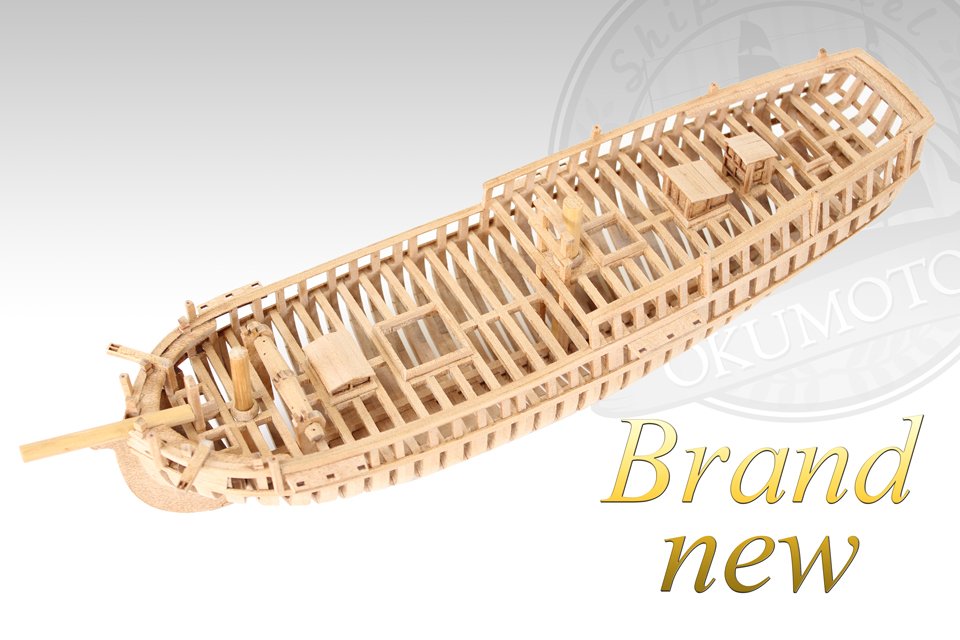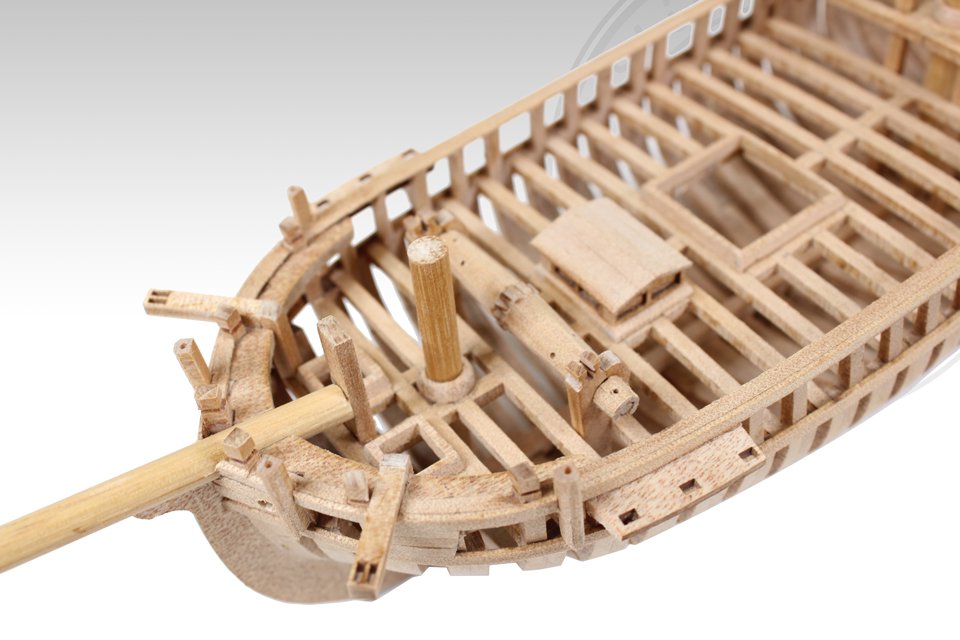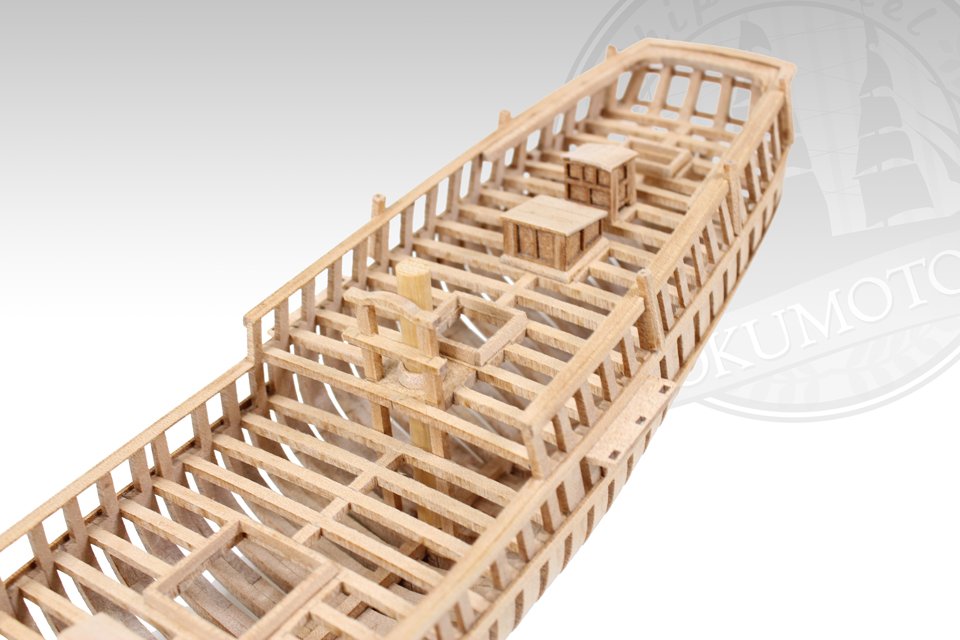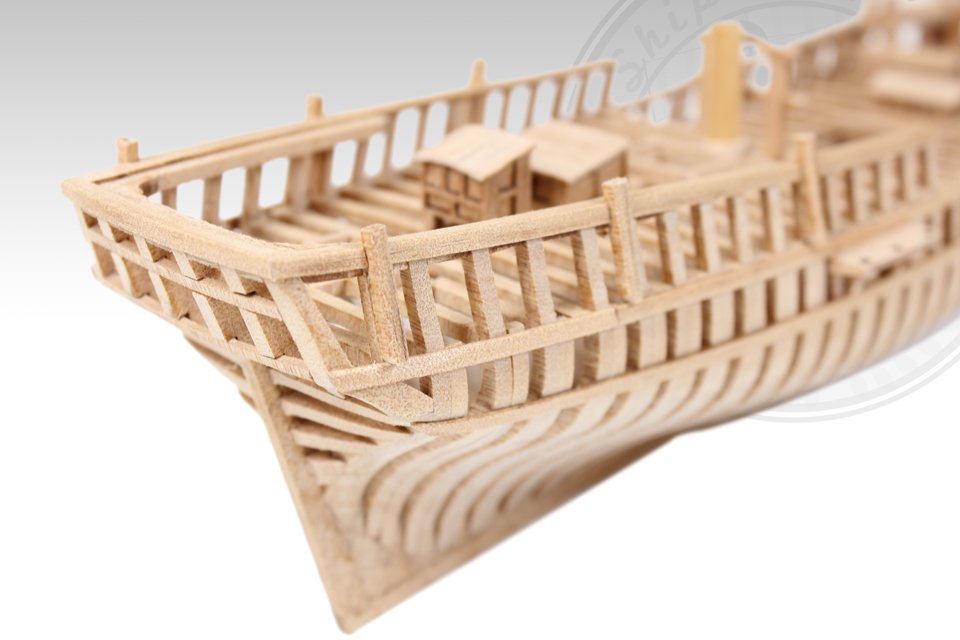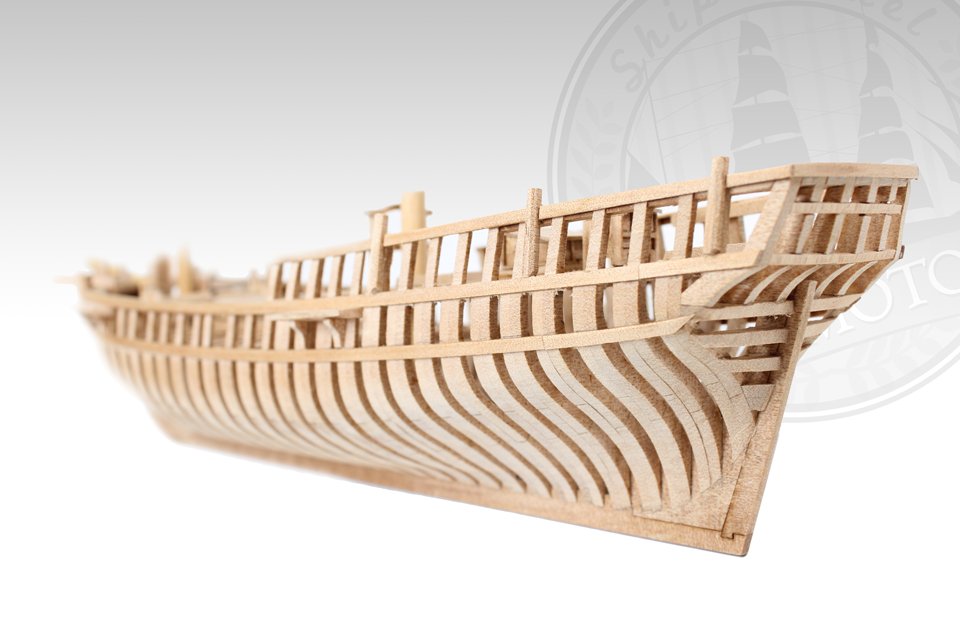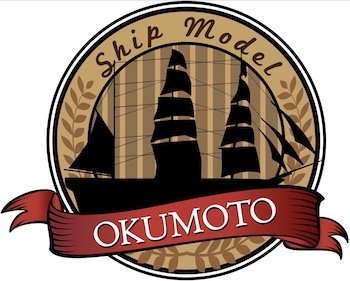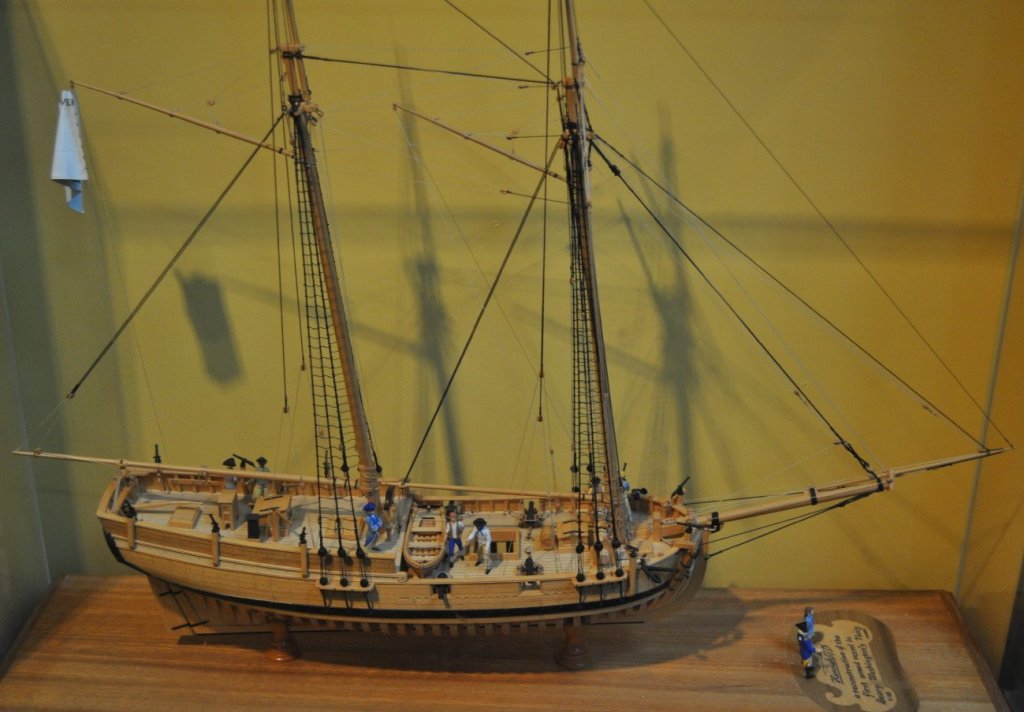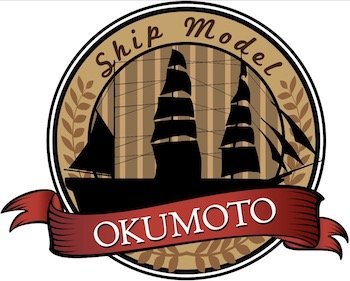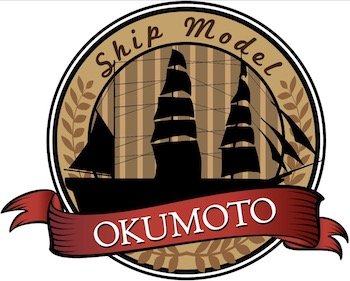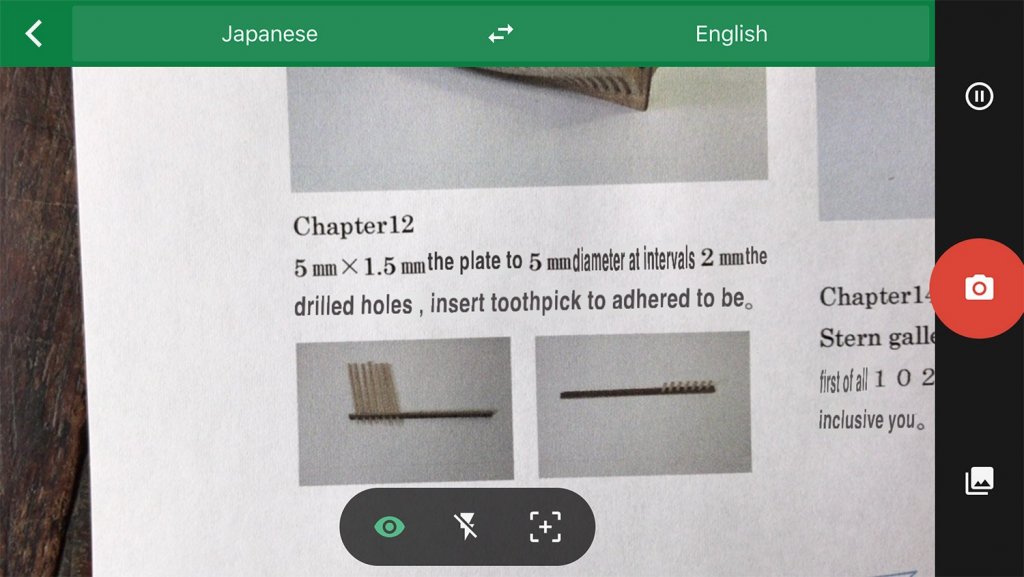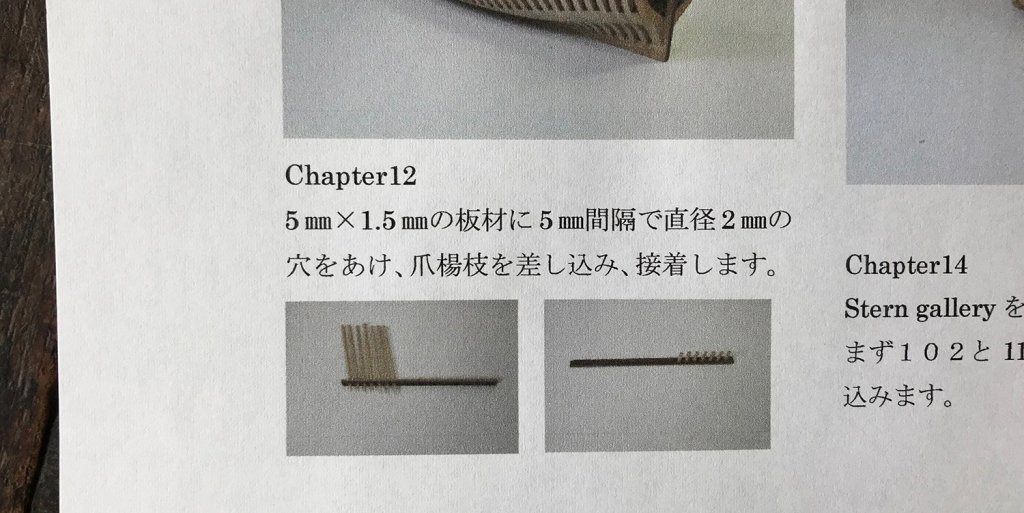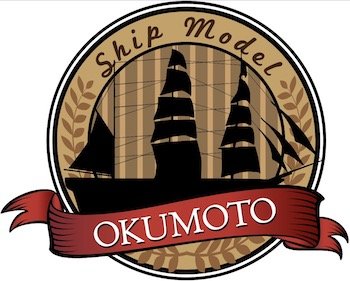Search the Community
Showing results for tags 'okumoto'.
-
1:70 Hannah Ship Model Okumoto Catalogue # Available from Ship Model Okumoto for ¥ 33,000 (approx. $290) The schooner Hannah was the first armed American naval vessel of the American Revolution and is claimed to be the founding vessel of the United States Navy. She was a fishing schooner owned by John Glover of Marblehead, Massachusetts and was named for his daughter, Hannah Glover. The crew was drawn largely from the town of Marblehead, with much of the ships ammunition being stored in Glover's warehouse now located at Glover's Square in Marblehead before being relocated to Beverly, Massachusetts. The schooner was hired into the service of the American Continental Army by General George Washington. Washington commissioned Nicholson Broughton to command the Hannah on 2 September 1775 and ordered the vessel to, "...cruize against such vessels as may be found . . . bound inward and outward to and from Boston, in the service of the [British] army, and to take and seize all such vessels, laden with soldiers, arms, ammunition, or provisions . . . which you shall have good reason to suspect are in such service." Hannah set sail from the harbour of Beverly, Massachusetts on 5 September 1775, but fled to the protection of the harbour of Gloucester, Massachusetts two days later under the pursuit of HMS Livelyand a second British vessel. Leaving Gloucester Harbour, Hannah captured HMS Unity. Hannah's brief naval career ended on 10 October 1775, when she was run aground under the guns of a small American fort near Beverly by the British sloop Nautilus. After a 4-hour engagement between the British ship and Beverly and Salem militias on the shore, Hannah was saved from destruction and capture. According to legend, soon after Hannah's decommissioning, the schooner was towed to Lee's Wharf in Manchester, where its name was changed to Lynch. There, the vessel was restored to working condition by 7 carpenters over the course of 3 weeks. In March of 1777, Lynch was sent to France with congressional correspondence for Benjamin Franklin, who was there as U.S. Ambassador. Upon embarking on their journey back to the U.S., Lynch and its crew were captured by British ship HMS Foudroyant. Lynch was sold as a prize by the British and documentation indicates that the schooner was used as a merchant vessel thereafter. Edit courtesy of Wikipedia The kit Hannah is the fourth release from Ship Model Okumoto and has only been on sale for a week or two, so my thanks to those guys for getting this out to me from Japan so quickly. According to their website, this is the kit specification: Scale: 1/70 Total length: 335mm Height: 90mm Width: 100mm Wood: Agathis Build time: 100 hours Parts count: 310 laser-cut parts, dowel As with my previous reviews for La Couronne, Endeavour and Santa Maria, this kit is packaged into a transparent, lockable box. However, this one is smaller, and our postie actually managed to pop it through our letterbox! As well as being smaller in general size, it’s about half of the depth of the previous releases and has some separate green plastic locking clips to hold it together. Inside, we have eight sheets of laser-cut Agathis wood, a small bundle of dowel, plans, instructions and a parts list. A hallmark of Okumoto’s kits is the very low scorch that results from cutting via laser. You can see that very little heat has crept into the area adjacent to the cut, and there is no discolouration of the parts. A simple clean-up of the edges is all that’s needed, so remember to do this to each inner frame edge and component before assembly. All parts are also nigh-on cut through in their entirety, so lengths of tape have been attached to the rear of the sheets, holding each part securely in place. Removal of the parts shows that no sticky residues are left behind either. As with the other kits, there is no part nomenclature on the sheets, and you need to refer to the paper plan sheets to identify each component. There is a little laser etching on each sheet which indicates the sheet number, for reference, and also the sheet thickness. Timber quality is excellent, with the Agathis being very fine grained. This should be nice and easy to work with, and you shouldn’t get any splitting etc. The slightly golden colour is also very attractive. Note that whilst these kits are POF, there are some simplifications in their construction. For example, these models don’t have cant frames. However, each frame is constructed from a number of individual components that would be similar to the way the actual ship frames were constructed. A small bundle of short dowel lengths concludes the timber items in this kit. Underneath the colour image of the completed Hannah, lies a profile plan that’s roughly A3 in size. This contains a port elevation as well as a partial upper and lower plan. Annotation is in English. We next have three sheets that contain the parts maps for the eight sheets of timber supplied. These are exact duplicates of the timber planks with regard to layout. Now, unlike the previous Okumoto releases, this one has a far more comprehensive instruction manual, again making this an ideal introduction to POF. Twelve sheets of paper are printed double-sided and stapled, creating a 24-page manual. Whilst this is still in Japanese, the photos are very good at explaining the steps. You can also use a smartphone app, such as Google Translate, so scan the text and convert it in real time. Lastly, a series of sheets are included which show the frame and detail assemblies. For the frames, you simply put these together over the top of the printed paper, after applying a little wax, maybe, to prevent the timber from sticking to your plans. Conclusion Out of all the Okumoto kits now on sale, Hannah has to take the place of Santa Maria as the first one that a newcomer to POF should tackle. Whilst Santa Maria is a beautiful and relatively uncomplicated in comparison to La Couronne and Endeavour, I feel that Hannah is well-pitched in complexity and price, to possible be the first POF from Okumoto that you consider due to its straightforward design. It’s worth noting that despite being an easier build subject, it still has almost twice the number of parts, according to their website, than Santa Maria. It’s also a little gem with its length of just over one imperial foot (13 inch, 335mm). A superb project that will look perfect on the mantlepiece and one that also won’t break the bank. Estimated building time is around 100hrs too. Please let Ship Model Okumoto know that you saw this review on Model Ship World. My sincere thanks to Ship Model Okumoto for sending this sample out for review on Model Ship World. To purchase directly, click the link at the top of the article.
-
1/80 Santa Maria Ship Model Okumoto Catalogue # SM-SMO-K80 Available from Ship Model Okumoto for ¥ 39,960 La Santa María de la Inmaculada Concepción (Spanish for: The Holy Mary of the Immaculate Conception), or La Santa María, originally La Gallega, was the largest of the three ships used by Christopher Columbus in his first voyage. Her master and owner was Juan de la Cosa. Santa María was built in Pontevedra, Galicia, in Spain's north-west region. Santa María was probably a medium-sized nau (carrack), about 58 ft (17.7 m) long on deck, and according to Juan Escalante de Mendoza in 1575, Santa Maria was "very little larger than 100 toneladas" (about 100 tons, or tuns) burthen, or burden, and was used as the flagship for the expedition. Santa María had a single deck and three small masts. The other ships of the Columbus expedition were the smaller caravel-type ships Santa Clara; one particular ship sailed for 46 years and was remembered as La Niña ("The Girl"), and La Pinta ("The Painted"). All these ships were second-hand (if not third- or more) and were not intended for exploration. Niña, Pinta, and the Santa María were modest-sized merchant vessels comparable in size to a modern cruising yacht. The exact measurements of length and width of the three ships have not survived, but good estimates of their burden capacity can be judged from contemporary anecdotes written down by one or more of Columbus's crew members, and contemporary Spanish and Portuguese shipwrecks from the late 15th and early 16th centuries which are comparable in size to that of Santa María. These include the ballast piles and keel lengths of the Molasses Reef Wreck and Highborn Cay Wreck in the Bahamas. Both were caravel vessels 19 m (62 ft) in length overall, 12.6 m (41 ft) keel length and 5 to 5.7 m (16 to 19 ft) in width and rated between 100 and 150 tons burden. Santa María, being Columbus' largest ship, was only about this size, and Niña and Pinta were smaller, at only 50 to 75 tons burden and perhaps 15 to 18 metres (49 to 59 ft) on deck. Extract courtesy of Wikipedia The kit This is the last of the first three ships that I have received for review here on MSW, until I receive the new release, Hannah, in the next week or so. Out of the initial three, this is the simplest of them all, and the least expensive, producing a nice rendition of a POF version of this legendary little ship. As with all Okumoto releases, this one again is packaged into a lockable, clear plastic box through which you can see the contents. Okumoto’s stats for this kit are as follows: overall length: 378 mm height: 139 mm Width: 103 mm Wood: Agathis Build time: approx 120 hours, laser-cut parts: 173 This kit has notably fewer planks within, with there being a dozen sheets of laser-cut Agathis wood, compared to double that of the Endeavour kit that we recently reviewed here on MSW (see end of article for links). Fewer sheets of timber of course yield fewer parts, with there being less than a third of the Endeavour, and a total of just 173. The model, whilst of the same scale as Endeavour, has a total length of 378mm, so in itself, is still a very reasonable size for display in a cabinet or on a mantlepiece etc. Looking at the various sheets, it is obvious that any scorching that inevitably results from laser-cutting, is at an absolute minimum as there is very little local heat transfer shown on the wood, and this is clearly seen in the photographs. Indeed, releasing a small number of parts from the Endeavour kit showed that the edges of the parts only seem to be a slightly darker brown, and this will be very easy to sand back to the nice bright timber colour underneath. Agathis wood can be cleanly cut with a knife when it comes to making any parts adjustments during construction, and the fine grain means that you shouldn’t experience anything untoward such as splitting or feathery edges when finishing the model. All parts are retained within their planks by the use of tape which holds things in position on the rear of the sheet. Removing the tape leaves no sticky residues either, and the parts will be ready for construction almost instantly. As no parts numbers etc. are etched to the sheets, for obvious reasons, you will need to reference the sheet against a paper parts plan. The sheet is easily recognised as each is etched with the sheet thickness and number. As per the real vessel, each frame is constructed from a number of timber parts, and these are built up over the frame plans which you should first smear with wax or cover with grease-proof paper so nothing unwanted sticks to your completed assemblies. You will note that not only are the regular frame parts etc. included, but also the strip wood, finely cut by laser. Be careful with these parts as they could well be fragile. To complete the timber contents, a small bundle of dowel is included for mast stubs etc. A colour-printed sheet showing the completed Santa Maria sits on top of the kit’s paper contents and provides the box-artillustration for this release, seen through the clear plastic container. Underneath this an A3-size plan lurks, with starboard and top-down views of the ship, clearly showing the main timber placements. Annotation is in English. Three pages are now included for the instruction/assembly sequence sheets. At the moment, these are supplied in Japanese only, but Okumoto tell me they will eventually provide these in English language text too, opening up their market possibilities. For the time though, you can use a phone app to translate in real time, such as Google Translate, that shows you the English equivalent when you hold the camera over the Japanese text. Four sheets of paper now include a parts plan for all of the sheet timber, providing easily referenced information when you come to locate specific elements for your build. The majority of the paperwork in this release provides plan layouts for the many frames in this ship. These are built directly over these sheets, and the frames are clearly numbered and identified. A handful of last sheets provides drawing data for specific elements of construction, with all annotation supplied in English. Conclusion I feel that this kit could be an ideal first introduction to a POF model, as it’s definitely less complex than La Couronne or Endeavour, and with a lesser parts count. General assembly looks easier too, but still maintains the overall busy look of a more complicated model. You’ll note that Santa Maria only has single frames and not the double of the previous releases, of course cutting down in the required number of timber parts. Production is excellent with cleanly-cut laser parts with hardly any charring, and a clear set of plans. The only drawback, at the moment, are the Japanese instructions, but that is easily overcome if you purchase now, and then there will be the English sheets which Okumoto will add in the future. In all, a very pleasing looking model and one at a size that will nicely fit in a small display cabinet. Give it a go!
-
1:80 Endeavour Ship Model Okumoto Catalogue # EV-SMO-K80 Available from Ship Model Okumoto for ¥ 60,480 HMS Endeavour, also known as HM Bark Endeavour, was a British Royal Navy research vessel that Lieutenant James Cook commanded to Australia and New Zealand on his first voyage of discovery from 1769 to 1771. She was launched in 1764 as the collier Earl of Pembroke, and the navy purchased her in 1768 for a scientific mission to the Pacific Ocean and to explore the seas for the surmised Terra Australis Incognita or "unknown southern land". The navy renamed and commissioned her as His Majesty's Bark the Endeavour. She departed Plymouth in August 1768, rounded Cape Horn, and reached Tahiti in time to observe the 1769 transit of Venus across the Sun. She then set sail into the largely uncharted ocean to the south, stopping at the Pacific islands of Huahine, Borabora, and Raiatea to allow Cook to claim them for Great Britain. In September 1769, she anchored off New Zealand, the first European vessel to reach the islands since Abel Tasman's Heemskerck 127 years earlier. In April 1770, Endeavour became the first ship to reach the east coast of Australia, when Cook went ashore at what is now known as Botany Bay. Endeavour then sailed north along the Australian coast. She narrowly avoided disaster after running aground on the Great Barrier Reef, and Cook had to throw her guns overboard to lighten her. He then beached her on the mainland for seven weeks to permit rudimentary repairs to her hull. On 10 October 1770, she limped into port in Batavia, Dutch East Indies (now named Jakarta) for more substantial repairs, her crew sworn to secrecy about the lands that they had visited. She resumed her westward journey on 26 December, rounded the Cape of Good Hope on 13 March 1771, and reached the English port of Dover on 12 July, having been at sea for nearly three years. Endeavour was largely forgotten after her epic voyage and spent the next three years sailing to and from the Falkland Islands. She was sold into private hands in 1775 and later renamed as Lord Sandwich; she was hired as a British troop transport during the American War of Independence and was scuttled in a blockade of Narragansett Bay, Rhode Island in 1778. Her wreck has not been precisely located but is thought to be one of a cluster of five in Newport Harbor. Relics are displayed at maritime museums worldwide, including six of her cannon and an anchor. Extract courtesy of Wikipedia The kit This is the second Okumoto kit that I’ve looked at, with the first being La Couronne. Read the review for that kit HERE. As with all of these kits, this one is also presented in a clear plastic, lockable box through which you can see the contents on offer. A colour print of the completed model is sat on top of the instructions, providing a kit identifier for you. Okumoto’s Endeavour is the most complex of the three kits currently on the market, with there being 626 laser-cut parts, and hence more timber. Of course, this is reflected in the cost of the kit too, with this one retailing at ¥ 60,480 (approx. £400, inclusive of taxes, at time of writing). This substantially heavy package also contains 44 sheets of plans and drawings to guide your build. Okumoto estimate that this project will take an average of 240 hours, so that would work out at £1.60/hr for your building enjoyment. Opening the lid and removing the paperwork, reveals a small bundle of dowel, some 1mm strip, and TWENTY-FIVE sheets of laser-cut Agathis wood, in 2mm, 3mm and 5mm thicknesses. Each sheet is around 30cm in length. The Agathis is a very nice-looking timber with a fine grain, and also a soft, golden colour. Of course, as these parts are laser-cut, there is some very localised scorching of the edges that you will need to sand away. As with the La Couronne kit, unlike some other laser-cut kits I’ve experienced, the char is very minimal (check my photo), and you can see from the photos how little of the heat has transferred into the timber. Another feature of Okumoto kits is that you don’t really have to use a knife to free any of the parts from the planks. All parts are 99.9% laser cut and are more or less sat in their respective holes and held in from behind with strip/strips of tape. The tape also doesn’t leave any annoying residues when removed either. Being a POF model, all timbers will be seen from one angle or another, and thus the parts numbers must be referenced against the sets of parts plans that are also included. The sheets do have the thickness of them laser-engraved, plus the sheet number to reference against the parts plans. Timber sheets not only include the various frames, beams, knees etc. but also strip wood which is also held in position with tape. These will be nice and easy to just pick one from the tape put it to use. Take care in removing any scorch though as these could be a little fragile. Overall dimensions of this model are very reasonable, with a length of 429mm, beam of 125mm, and a height of 130mm. Of course, this isn’t a masted model, but simply has the stub masts in situ, as seen on shipyard-style models. A colour-printed sheet is included which shows you the completed POF Endeavour, and very attractive it looks. Under this sheet is an A2-size plan which has a starboard and upper profile, with English annotation. Next, a 5-page instruction manual is supplied, with photographs used to guide you through construction. Unfortunately, all the text is in Japanese, but you can use a phone-based app to translate this in real time. Okumoto also tell me that they will start to include English language instructions in the near future. Nine sheets of paper are included as a parts plan for easy identification of the 626 components that will go to create your Endeavour. These also have some English-language annotation in areas. Twenty-three sheets now show the frame construction, including deck beam positions etc. These need to have the parts sat upon them and positions of the various components marked out on the wood. It’s a time-consuming task, but that’s the nature of POF. The result should be very impressive. A further 11 sheets show Endeavour in more plan detail, with particular areas of construction singled out so you know exactly where each component will fit. Conclusion Another high quality release from Okumoto, and certainly the most involved of all the three releases that I have received. As with La Couronne, no gratings are included, so you might like to source them yourself. I think a little deck planking would also enhance the model further, applied in sections so as not to obscure the majority of the deck beams. As this is the most complex of the three releases from Okumoto, I would perhaps suggest one of their simpler models first, as an introduction to POF. That would be the Santa Maria (reviewed next week), or their soon-to-be-released kit, ‘Hannah’. If you are already proficient in our hobby though, then this kit shouldn’t really challenge you too much, and you’ll end up with an extremely attractive model for your shelf. Okumoto’s approach to construction should provide a very satisfying workbench experience and something a little different too. My sincere thanks to Ship Model Okumoto for kindly sending this sample out for review on Model Ship World. To purchase directly, click the link at the top of this article.
-
1:123 La Couronne Ship Model Okumoto Catalogue # LC-SMO-K80 Available from Ship Model Okumotofor ¥ 51,840 Couronne (French for "crown") was an emblematic ship of the French Navy built by order of Richelieu. The Couronne was the first major warship to be designed and built by the French themselves in accordance with Richelieu's plans to renew the French Navy, after a series of warships had been built by the Dutch. The construction was supervised by Isaac de Launay Razilly (died in Arcadia 1635), and overseen by the famous carpenter Charles Morieu, from Dieppe. She was being constructed at La Roche-Bernard and was one of the most advanced units of her time. After launch in 1632 or 1633, she was moved to Brouage in September 1634 where she was completed around 1635 by Mathieu Casteau. She carried up to heavy guns, most on her two-deck broadside but also 8 firing forwards from the bow and 8 firing aft, an unusual feature until Dupuy de Lôme redesigned naval artillery. Couronne took part in the Battle of Guetaria on 22 August 1638, and another expedition to Spain in 1639 under Henri de Sourdis. The ship was disarmed in 1641 and scrapped between 1643-1645. Extract courtesy of Wikipedia The kit Ship Model Okumoto isn’t a name that you’re likely to have encountered much, if at all, during your exploration of this hobby. They are one of an extremely minor number of Japanese companies who are producing wooden ship kits. In fact, the only other company that I can think of is WoodyJoe, and they don’t sell these frame-style models that Okumoto are now selling. At the moment, Okumoto only produce three of these kits, with a fourth being released in the next weeks. Model Ship World has been sent all three current releases for review, so I thought we’d first take a look at this most famous of French ships. If you expect your model ship to be packaged into the typical cardboard box with glossy box art and other such niceties, then this might just surprise you. Okumoto has chosen a lockable, clear plastic case to package their kits into, and there is no box art. This simple approach has its identity defined by the set of instruction sheets that has a photo of the finished model sat on top of the timber parts. It’s as simple as that. Whilst unconventional, this approach is actually quite charming and certainly engaging. Opening the box reveals three stacks of laser-cut wood (Agathis), a small bundle of thin strip wood, short dowel sections and a packet with five bundles of toothpicks. The latter have quite ornate turning on their blunt end and have obviously been chosen for this purpose. I remember using the same thing when I built my Panart San Felipe. There are 26 sheets of accompanying plans and drawings, plus the colour laser-printed image of the finished vessel. I know that there are a number of modellers who aren’t fans of laser cut wood due to the scorched edges, but the heat from this laser seems to have been very localised and not caused as much as is seen on contemporary kits. Look at this photo to see what I mean. On the reverse of each sheet are a few lengths of sticky tape. This is designed to hold the parts in their respective places because with this kit, there is no reason to cut the parts from the sheets! Yes. They are completely cut out and ready to use! Removing the parts also shows that no sticky residues are left from the tape, so this isn’t a concern. As this model is going to be POF, it’s pretty important that there aren’t any unwanted nasties to overcome, such as numbering of the components. This is also correct as the part numbers for each sheet are supplied on the accompanying plans. Another feature of each laser-cut sheet is the thickness of the timber and sheet number, laser-engraved onto the end of each one, making identifying even easier. Most of the strip material is cut from the same timber and in the same fashion with the tape holding the strips in place. Dowel and separate strip wood is high quality too, but I’m unsure as the material used for the latter. Those bundles of toothpicks are very good too, with no low-quality material that splits and splinters. Underneath the colour print of the finished La Couronne, lurks a 6-page photo driven instruction manual. Now, here’s the rub…it’s all in Japanese! The various sizes etc. are understandable, so you will need to the aid of a mobile app, such as Google Translate, so scan and change the language into your own native brand. That app actually works pretty well on this sort of thing. Check out this screenshot comparison. Next up is an A2 sized plan, printed at actual scale to the model. All text and dimension on this is printed in English, and the drawings include an above elevation and a starboard side profile. A further six sheets show the parts plan for the laser-cut timber, simply for referencing purposes. Each frame is now shown on the next series of drawings, indicating joints and positions for the deck beams. There will be course need to be some tracing of positions from these to the timber parts. The remainder of the plans contain drawings which pertain to the fitting of rails, lodging knees and just about every other aspect of the model, in more precise detail that the previous plans. Whilst Japanese text is present, so is English text, so there shouldn’t be any confusion in what you are studying. All plans also show the specific part numbers for just about everything, whether you need to know them or not. Conclusion La Couronne is, according to Ken at Okumoto, one of the most popular model ship designs in Japan because the shape is very appealing to wooden ship builders. This kit, at time of writing, is their latest release, and Okumoto misjudged how popular it would be with customers and as a result, they quickly ran out of the first production batch. Whilst the model itself is superbly designed and produced with high quality, there are perhaps a couple of areas where artistic licence/vs simplicity might have crept in, but that really doesn’t detract from what is otherwise a highly attractive and authentic-looking POF build of this historical vessel. You could, if you wished, go even further with the model and add internal deck planking etc. For me, the model is perfect without any added embellishment and will provide the modeller with a challenge and a great introduction into the world of POF ships, and without any real compromise in the standard of the finished build. These aren’t cheap models by any stretch of the imagination, so I would ensure that you’ve a number of completions under your belt before diving into an Okumoto kit. I would say these are an excellent transition kit between POB and POF, if POF was what you really wanted to tackle, but didn’t have the tooling to do so. I think the only thing I would’ve liked to have seen included are the gratings. I don’t know how easy they would be to replicate in this scale, but may try to add them myself. There are two previous releases to this. These are Santa Maria and Endeavour, and I will be looking at these too over the next weeks. My sincere thanks to Ship Model Okumoto for kindly sending this sample out for review on Model Ship World. To purchase directly, click the link at the top of this article.
-
- la couronne
- couronne
-
(and 1 more)
Tagged with:
About us
Modelshipworld - Advancing Ship Modeling through Research
SSL Secured
Your security is important for us so this Website is SSL-Secured
NRG Mailing Address
Nautical Research Guild
237 South Lincoln Street
Westmont IL, 60559-1917
Model Ship World ® and the MSW logo are Registered Trademarks, and belong to the Nautical Research Guild (United States Patent and Trademark Office: No. 6,929,264 & No. 6,929,274, registered Dec. 20, 2022)
Helpful Links
About the NRG
If you enjoy building ship models that are historically accurate as well as beautiful, then The Nautical Research Guild (NRG) is just right for you.
The Guild is a non-profit educational organization whose mission is to “Advance Ship Modeling Through Research”. We provide support to our members in their efforts to raise the quality of their model ships.
The Nautical Research Guild has published our world-renowned quarterly magazine, The Nautical Research Journal, since 1955. The pages of the Journal are full of articles by accomplished ship modelers who show you how they create those exquisite details on their models, and by maritime historians who show you the correct details to build. The Journal is available in both print and digital editions. Go to the NRG web site (www.thenrg.org) to download a complimentary digital copy of the Journal. The NRG also publishes plan sets, books and compilations of back issues of the Journal and the former Ships in Scale and Model Ship Builder magazines.


